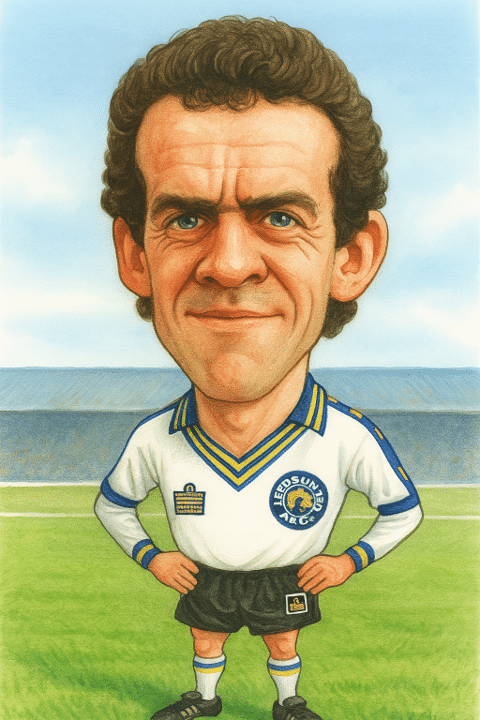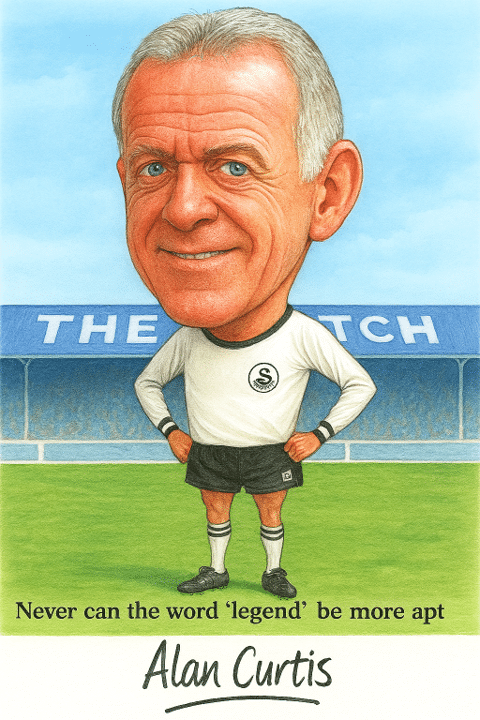Few players embody the spirit of a football club quite like Alan Curtis does at Swansea City. Across multiple spells spanning nearly two decades, Curtis became synonymous with the Swans. He was a creative forward whose intelligence, movement and understated leadership helped shape the club’s rise through the divisions. For three seasons in the mid-1980s, Curtis also wore the red and white of Southampton, contributing to a side that regularly challenged in the top half of the First Division.
This Wore Both Colours feature revisits the career of a player whose name is etched into Swansea folklore, but who also made a meaningful contribution on the South Coast. From his early days in the Rhondda Valley to his final coaching role at the Liberty Stadium, Curtis’s journey is one of loyalty, adaptability and quiet excellence. His time at Southampton may have been shorter, but it came during a competitive era for the club and his performances earned respect from teammates and supporters alike.
In tracing Alan Curtis’s path from Ton Pentre to Leeds, from Vetch Field to The Dell, we explore the story of a player who bridged divides, returned home more than once and left a legacy that continues to shape Swansea City to this day.
🧒 Alan Curtis: The Beginning
Alan Thomas Curtis was born on 16 April 1954 in Pentre, a village in the Rhondda Valley of South Wales. His father, Albert, worked as a coal miner, while his mother, Tydfil, was employed in a local factory. Football ran in the family. His uncle Roy Paul had captained Wales and played for Manchester City in the 1956 FA Cup Final.
Curtis showed early promise and represented Rhondda Schools, earning recognition at youth level. At 13, he had an unsuccessful trial with Manchester United but chose to focus on his education, remaining at his local grammar school to complete his A-levels. By the time Swansea City offered him a trial in 1972, he had already earned a cap for Wales at under-18 level.
His decision to pursue football professionally came after that trial at Vetch Field, where manager Roy Bentley handed him his league debut in August 1972 in a 3–1 defeat to Southend United. Although Swansea were relegated that season, Curtis had made 14 appearances and begun a journey that would define his career and his connection to the city.
🦢 Swansea City 1972 to 1979
Alan Curtis’s emergence at Swansea City coincided with one of the most turbulent periods in the club’s history. Having joined in 1972, he quickly became a fixture in the side, offering pace, balance and technical quality in a team that was otherwise short on confidence. Swansea were relegated to the Fourth Division in his first season, but Curtis’s performances stood out, laying the foundation for what would become a transformative role in the club’s revival.
Initially used as a winger, Curtis’s ability to drift inside and link play made him a valuable attacking option. Under Harry Griffiths, his role evolved into a more central position, allowing him to influence games more directly. His intelligence off the ball and composure in front of goal made him a consistent threat, and his goal tally began to climb.
The arrival of John Toshack in 1978 marked a turning point. With Curtis already established as a key player, Toshack built a side capable of climbing the divisions. Swansea secured back-to-back promotions, rising from the Fourth Division in 1978 and the Third Division in 1979. Curtis was instrumental in both campaigns, scoring 34 goals in the 1977 to 1978 season alone.
His club form earned international recognition. Curtis made his senior debut for Wales in March 1976 against England, having previously represented his country at youth and under-21 levels. By the end of the decade, he had made 248 league appearances and scored 71 goals for Swansea, becoming one of the most influential players in the club’s modern history.
🟡 Leeds United 1979 to 1980
In May 1979, Alan Curtis made the move to Leeds United for a reported fee of £370,000. The transfer came after back-to-back promotions with Swansea City and a desire to test himself in the First Division. Leeds, managed at the time by Jimmy Adamson, were looking to refresh their attacking options and saw Curtis as a player with the technical ability and experience to make an impact.
Curtis made his debut for Leeds on 18 August 1979 in a 2–2 draw away to Bristol City. He featured regularly throughout the 1979 to 1980 season, making 28 league appearances and scoring five goals. Despite flashes of quality, Curtis struggled to replicate the form he had shown at Swansea. Leeds were in a transitional phase, and the team’s inconsistency made it difficult for Curtis to settle into a defined role.
By the end of the season, Curtis had requested a return to South Wales. Swansea, now in the Second Division and continuing their upward trajectory under John Toshack, re-signed him in the summer of 1980. His time at Leeds had lasted just one season, but it marked his first experience of top-flight football and added a new dimension to his career.
🏟️ Swansea City 1980 to 1983
Alan Curtis returned to Swansea City in the summer of 1980, just one year after leaving for Leeds United. The club, under the management of John Toshack, had secured promotion to the Second Division and were building a squad capable of reaching the top flight. Curtis rejoined for a fee of £175,000 and was immediately restored to the first team.
His second debut came early in the 1980 to 1981 campaign, and he played a key role in helping Swansea secure promotion to the First Division for the first time in the club’s history. The following season began with a landmark fixture, Swansea’s first ever top-flight match, played at a sun-drenched Vetch Field against Leeds United. Curtis scored the fifth goal in a stunning 5–1 victory, sealing a perfect start to life in the First Division and marking a personal triumph against his former club.
The 1981 to 1982 season proved to be the high point of Swansea’s rise. The team finished sixth in the First Division, with Curtis contributing seven goals in 36 league appearances. His link-up play with Leighton James, Robbie James and Jeremy Charles gave Swansea a fluid attacking style that won admirers across the league.
However, the momentum faltered the following year. Injuries, financial strain and loss of form led to relegation in 1982 to 1983. Curtis remained a consistent performer, but the club’s decline was evident. In November 1983, he left Swansea for Southampton, closing his second spell with 90 league appearances and 21 goals.
⚓ Southampton 1983 to 1986
Alan Curtis joined Southampton in November 1983 for a transfer fee of £80,000. The move came after Swansea’s relegation from the First Division and a period of financial instability at the club. Southampton, managed by Lawrie McMenemy, had long admired Curtis and finally secured his signature after previously attempting to sign him earlier in his career.
Curtis made his league debut for the Saints on 3 December 1983 in a 3–1 home win against Stoke City. His first season was disrupted by injury, including a hamstring problem sustained early in his Southampton career. Despite limited appearances in 1983 to 1984, he remained part of a squad that reached the FA Cup semi-finals and finished second in the First Division.
The 1984 to 1985 season saw Curtis feature more regularly. He made 30 league appearances and scored four goals, often deployed in a deeper midfield role that showcased his versatility. His technical ability and reading of the game allowed him to adapt to different positions, and he became a reliable presence in a side that included players like Steve Moran, David Armstrong and Mark Wright.
In his final season at The Dell, Curtis made 11 league appearances and scored once. With managerial changes and new signings altering the squad dynamics, his role became more peripheral. In July 1986, he left Southampton to join Cardiff City, closing his spell on the South Coast with 50 league appearances and five goals.
🔵 Cardiff City 1986 to 1989
In July 1986, Alan Curtis made the move to Cardiff City, crossing the South Wales divide after three seasons at Southampton. The transfer raised eyebrows given his long-standing association with Swansea, but Curtis quickly won over the Ninian Park faithful with his professionalism and performances on the pitch.
Cardiff were competing in the Third Division at the time and looking to rebuild. Curtis brought experience, composure and a touch of class to the side. He was often deployed in a deeper role, using his vision and passing range to link midfield and attack. His influence extended beyond matchdays, with younger players benefiting from his example and leadership.
One of his standout moments came in the 1988 Welsh Cup Final, held at the Vetch Field. Curtis opened the scoring with a well-taken goal in a 2–0 win over Wrexham, helping Cardiff lift the trophy on Swansea soil. It was a symbolic moment for a player who had earned respect on both sides of the South Wales divide.
Despite his Swansea roots, Curtis became a respected figure at Cardiff. He made 101 league appearances and scored 10 goals during his three-year spell, helping the club stabilise and compete in the middle of the table. His ability to bridge rival loyalties with dignity and commitment earned him admiration across South Wales.
⚪ Swansea City 1989 to 1990
Alan Curtis returned to Swansea City for a third and final time in the summer of 1989. Now 35 years old, he was entering the final chapter of his playing career but remained a valuable presence both on and off the pitch. Swansea were competing in the Third Division and looking to stabilise after a period of decline.
Curtis made 28 league appearances during the 1989 to 1990 season, scoring twice. His experience and understanding of the club’s identity made him a natural mentor for younger players, and his professionalism continued to set the standard in training and match preparation.
Although his pace had diminished, Curtis’s technical ability and positional awareness allowed him to contribute meaningfully throughout the campaign. His final appearance came in April 1990, bringing to a close a playing career that had spanned nearly two decades and more than 400 league appearances for Swansea City.

🧤 The End of His Playing Career
Alan Curtis brought his professional league career to a close in 1990 after his final season with Swansea City. But he wasn’t quite finished. He continued playing in the Welsh domestic system, first joining Barry Town for the 1990 to 1991 season, where he made 50 appearances and scored five goals.
After a brief hiatus, Curtis returned to Barry in 1994 for a short spell, adding another 13 appearances and one goal to his tally. He also played for Haverfordwest County during the early 1990s, extending his career well beyond the Football League and contributing to the growth of Welsh club football.
His final competitive appearances came in 1994, bringing to an end a playing career that spanned over two decades, more than 600 senior appearances and 121 goals. Curtis retired with six goals in 35 caps for Wales and a reputation as one of the most respected figures in Welsh football.
🧠 Post-Playing Career and Coaching
After retiring from competitive football in 1994, Alan Curtis moved seamlessly into coaching and development roles, beginning a new chapter of service to Swansea City. He initially worked with the club’s youth teams before taking on more senior responsibilities, including assistant manager and caretaker manager across multiple spells.
Curtis became a trusted figure behind the scenes, known for his calm authority, deep understanding of the game and unwavering loyalty to the club. He served under a succession of managers including Roberto Martínez, Brendan Rodgers, Michael Laudrup and Garry Monk, helping guide Swansea through their rise to the Premier League and their consolidation as a top-flight side.
In 2015, Curtis stepped in as caretaker manager following the departure of Garry Monk, stabilising the team during a difficult period. He reprised the role again in 2016 and 2017, each time providing steady leadership and continuity. His presence on the touchline became symbolic of the club’s values: humility, resilience and connection to the community.
Curtis retired from full-time coaching in 2019 but remained involved as Swansea’s honorary club president. His legacy is visible not just in the club’s history books but in the culture he helped shape across generations.
🪞 Legacy and Reflections
Alan Curtis’s legacy is woven into the fabric of Welsh football. As a player, he was graceful, intelligent and quietly influential. As a coach and mentor, he became a guiding presence for generations of Swansea players and staff. Few figures have served a single club in so many capacities: player, coach, caretaker manager, ambassador and president.
His contribution to Swansea City spans more than 50 years. From the Fourth Division to the Premier League, Curtis was there through every rise and fall, offering continuity and calm. His ability to adapt, to lead without ego and to represent the club’s values made him a rare figure in modern football.
Beyond Swansea, Curtis earned respect at Leeds, Southampton and Cardiff, bridging rivalries with dignity and professionalism. His six goals in 35 caps for Wales included appearances against England, Scotland and Yugoslavia. He remains one of the most capped players to have spent the majority of his career outside the top flight.
Curtis has spoken often about the importance of humility, hard work and staying grounded. His story is not one of flash or fame, but of consistency, loyalty and quiet excellence. In South Wales, he is more than a footballer. He is a symbol of what it means to serve a club and a community with heart.

This article first appeared on JACKARMY.net.


2 replies
Loading new replies...
First Team Player
Tommy Hutchison
Join the full discussion at the Welcome to the Lord Bony Stand →